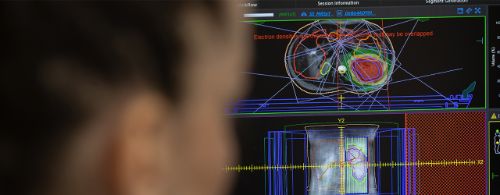Radiotherapy
"The techniques applied in the Radiation Oncology at the Clínica Universidad de Navarra are of the latest generation and are currently only available in a few centres in Spain".
DR. JAVIER ARISTU DIRECTOR. RADIOTHERAPEUTIC ONCOLOGY DEPARTMENT

What is radiotherapy?
Radiation therapy uses ionizing radiation for therapeutic purposes. Its mechanism of action is based on direct and indirect damage to cellular DNA that produces functional and/or structural alterations and ultimately cell death.
The most common way of administering external radiotherapy is through devices called linear accelerators. They have the capacity to produce and accelerate the electrons generated in a filament by thermal effect to which a potential difference (electric current) is applied and accelerates the electrons.
The Clinic has the VERSA HD accelerator, considered the most advanced for treatments with external radiotherapy. It offers a treatment speed up to ten times higher than that of any conventional accelerator, together with greater precision in the administration of the dose.
This high speed in the administration of the treatments occurs because the dose rate of the radiation beam is much higher with the new accelerator than with the previous ones. Thus, this equipment makes it possible to administer very high doses of irradiation in a very short time.

A PERSONALIZED MEDICINE
Second Opinion,
peace of mind
Request a second opinion from our professionals with great experience in the diagnosis and treatment of oncological diseases
In 3 days, without leaving home.
When is radiotherapy indicated?
In general, cancer treatment is done by combining surgery, chemotherapy and radiotherapy.
Excluding very early tumors that can be cured with exclusive radiotherapy, radiotherapy is one more part of the cancer treatment and it is usually given before or after surgery and before, simultaneously or after chemotherapy.
Radiation therapy is also indicated to relieve pain and symptoms produced by tumors spread to the bones, brain or other locations.
Most frequent indications for radiotherapy:
Do you have any of these diseases?
You may need to be treated with radiation therapy
External Radiation Therapy
In external radiotherapy the source of radiation is far from the patient and high energy radiation beams with great capacity of tissue penetration are used.
External radiotherapy is classified according to the purpose of the treatment in radical radiotherapy when it is applied exclusively, being the only treatment the patient needs, adjuvant or complementary radiotherapy if it is administered after or before the primary treatment of the cancer, prophylactic radiotherapy if the intention is to prevent the appearance of metastasis in a certain location and palliative radiotherapy when the intention of the treatment is to reduce the symptoms produced by the growth of the cancer.
External radiotherapy is also classified according to the combination with other treatments in postoperative radiotherapy if it is administered after surgery in order to sterilize the small microscopic amounts of cancer that may have remained, preoperative radiotherapy if it is applied before surgery with the intention of reducing the tumor so that the operation is less extensive, simultaneous or concomitant radiotherapy if it is combined simultaneously with chemotherapy and intraoperative or perioperative radiotherapy if it is administered at the same surgical act or in the immediate postoperative period.
Radioterapia interna
Internal brachytherapy or radiation therapy uses radioactive material inside the tumor or in surrounding tissues.
The radioactive sources used are low-moderate energy radioisotopes and limited tissue penetration.
The most clinically applicable radioisotopes are cesium, iridium, iodine, and palladium. They are applied in the form of thin wires, capsules or seeds and are distributed in sealed containers.
Depending on the location of the applicators (devices through which the radioisotope is introduced), brachytherapy can be intracavitary if introduced into a natural cavity (esophagus, vagina), interstitial if the radioisotope is introduced directly into the tumor and superficial if the radioisotope is deposited on a surface (skin).
Depending on how long the radioactive source remains in the tumor, brachytherapy implants may be temporary or permanent.
The radioactive implants can be of high rate, medium rate or low dose rate depending on whether the radioactive source releases a certain dose of radiation in a shorter, intermediate or longer time respectively.
How is radiotherapy performed?
A specially trained team of professionals led by a radiation oncologist participates in the radiotherapy treatment.
The radiation oncologist is a physician specializing in radiation oncology who develops, prescribes and supervises the radiation treatment plan. He can modify the treatment depending on the patient's evolution, identifies and treats the adverse effects of irradiation and collaborates with other specialists involved in the multidisciplinary treatment of cancer such as medical oncologists and surgeons.
Medical physicists work closely with the radiation oncologist in planning and administering treatment. They supervise the work of the dosimetrist and are directly involved in planning complex treatments. In addition, they develop and manage treatment unit quality programs and perform tests to establish the proper functioning of the units and the quality of the radiation beam.
The dosimetrists work together with the radiation oncologist and the medical physicist to select the radiation technique capable of generating the best distribution of the radiation dose over the tumor and the greatest exclusion of radiation doses to healthy tissues. The work is done on computers that use complex calculation algorithms capable of processing different types of images.
The radiotherapy technician is the person in charge of performing the daily radiation treatment supervised by the physician. He or she must be meticulous in the daily immobilization and positioning of the patient, ensure that the proper treatment has been done, and make a daily record of the treatment.
The radiation oncology nurse works with the entire treatment team to address the needs of the patient and family before, during and after treatment. They explain the care to be taken during and after irradiation and possible adverse effects and how to treat them.
Other health professionals involved in the care of these patients include medical nutritionists, physical therapists, dentists, and social workers.
Prior to treatment with radiation therapy, the medical radiation oncologist talks with the patient and explains the benefits and risks of treatment as well as other existing therapeutic possibilities.
Afterwards, the simulation is performed, which consists of taking measurements and drawing references on the skin to facilitate the entry of external radiation beams through the skin in a precise and reproducible way in each of the treatment sessions. The patient is immobilized in a comfortable and reproducible position that will be used daily during the irradiation.
For the immobilization of the patient, different devices are used such as thermoplastic masks, vacuum or catalytic resin mattresses, inclined planes, etc., selecting a certain method of immobilization depending on the tumor location and the required precision of the case.
Under these conditions of immobilization and fixation of the patient, a planning CT scan is performed and the corresponding axial images are acquired. These CT images are sent to a computer for virtual planning of the radiation treatment. In the planning computer, a certain photon energy, the number of radiation fields (usually two to four) and the rotation angles of the accelerator head are chosen.
Several treatment plans are generated and the radiation oncologist selects the plan that presents an optimal radiation dose distribution capable of maximizing the radiation dose to the tumor while minimizing the dose to adjacent normal structures.
Finally, the patient starts the treatment in the same position in which the simulation and planning procedures have been performed, after verifying the radiotherapy fields, which is done by comparing images reconstructed in the virtual planning with real images of the patient himself generated by means of a radiographic plate or digital portal images.
The treatment with radiotherapy is painless and the patient does not notice any type of sensation. It is administered on an outpatient basis in the form of daily sessions (fractions), five days a week, from Monday to Friday, resting on Saturdays and Sundays up to a total of 25-40 fractions depending on the type of tumor treated.
Sometimes the treatment has to be interrupted for a day or more due to the appearance of adverse effects and is resumed when these have improved or disappeared.
During the treatment, check-up X-rays and weekly check-ups are scheduled with the radiotherapy oncologist and the nurse to observe the evolution, the adverse effects and recommend treatment if necessary.
It is usual to recommend to patients certain care and habits during and after the irradiation such as getting enough rest, following a balanced and nutritious diet and paying special attention to the skin that may become sensitive and red.
After treatment, the patient is scheduled for an appointment to check on his recovery and the evolution of the cancer.
In general, radiotherapy is well tolerated and many patients are able to carry out their normal activity, however, in some patients adverse effects may appear that are generally limited to the treated area.
The adverse effects of radiotherapy are acute when they occur during the treatment period and in the ninety days that follow. They are the result of an inflammatory process derived from the depletion of progenitor cells from rapidly growing tissues such as skin, mucous membrane of the oral cavity and gastrointestinal tract, hematopoietic tissue, hair follicle, etc.
These acute adverse effects are transitory and recoverable due to the repair capacity of healthy tissue. They usually appear after the second or third week of treatment and may last for several weeks after treatment.
The most frequent symptom is fatigue, which is not usually disabling. Mucositis (inflammation of the oral mucosa), esophagitis (inflammation of the esophagus), enteritis (inflammation of the small intestine), epithelitis and dermatitis (inflammation of the skin), alopecia and spinal cord aplasia are the most frequently observed acute adverse effects. On many occasions it is necessary to administer anti-inflammatory treatment, feeding with special means and less commonly, hospital admission for hydroelectrolyte replacement.
Chronic adverse effects are observed 90 days after the end of radiotherapy and are the result of a process of tissue transformation derived from the depletion of slow-growing cells such as muscle, renal and hepatic parenchyma, nervous tissue, etc.
These chronic adverse effects are not recoverable and are permanent, constituting the most important limiting factor of clinical radiotherapy, although it is true that the probability of the appearance of chronic adverse effects is low.
Among the chronic adverse effects are xerostomia or loss of saliva, fibrosis or hardening of the subcutaneous tissue, lung or intestine, necrosis, neurological damage and in the pediatric population, growth retardation, hormonal alterations and the appearance of second tumors.
Where do we do it?
IN NAVARRA AND MADRID
The Department of Radiation Oncology of the Clínica
of the Clínica Universidad de Navarra
The Clínica Universidad de Navarra's Department of Radiation Oncology has extensive experience in external and intensity-modulated radiotherapy. In addition, we apply various state-of-the-art medical-surgical techniques available in a few Spanish centers.
We are one of the international reference centers in the performance of intraoperative implants and radiation treatment with high rate brachytherapy technique during the postoperative period.
We have one of the most extensive experiences worldwide in the treatment of intraoperative brachytherapy of head and neck tumors, soft tissue sarcomas and gynecological tumors.
Treatments we perform

Why at the Clinica?
- Expert professionals of reference at international level.
- Greater accessibility for national and international patients.
- State-of-the-art technology, the most advanced in Spain.
- The most advanced proton therapy unit in Europe at the Madrid headquarters for the treatment of cancer with protons.
Our team of professionals
Proton Therapy
Unit
The Clinica has the most advanced Proton Therapy Unit in Europe at its headquarters in Madrid.
Proton therapy provides very promising results with minimal side effects in pediatric tumours, and those of the skull base, brain, head and neck.
It incorporates, for the first time in Europe, a Hitachi device, that is present in academic medical centres of international reference.

MR Linac
MRI-guided radiation therapy
MR Linac is an advanced radiotherapy technology that combines a linear accelerator with an integrated 1.5 Tesla magnetic resonance imaging system, with high diagnostic accuracy before, during and after treatment.
MR Linac technology allows real-time adaptive radiotherapy to be administered, which adapts the dose and precision of the radiotherapy administered to the patient according to the specific characteristics of each person and each tumor.














